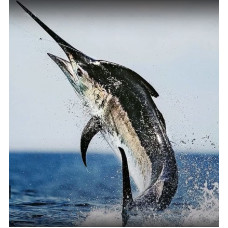Latin name
Istiompax indica
Other names
Istiompax indica
Identification
The body is elongated, not strongly compressed at the sides, covered with dense, thick, elongated scales with one or two sharp points on the posterior margin. One lateral line, clearly visible in young fish but becoming almost invisible with age. The snout is elongated into a long, very strong "spear", which is circular in cross section. The gill membranes are fused, there are no gill stamens. There are small, file-like teeth on both jaws and the palate. The caudal peduncle is compressed laterally and slightly dorso-ventrally, with two strong keels on each side of the peduncle. The anal opening is located near the beginning of the first anal fin. The fish has 24 vertebrae.
Features of fish fins
The two dorsal fins are separated by a small gap. The first dorsal fin has a very long base with 34-43 soft rays. The first rays are much higher than the rest, but still quite low, their height not exceeding the height of the body. The second dorsal fin is short with 5-7 soft rays, beginning just before the vertical of the beginning of the second anal fin. The first anal fin has 10-14 soft rays and the second anal fin has 5-7 soft rays. The pectoral fins are almost perpendicular to the body and must not press against it. The caudal fin is monthly shaped.
Fish colouring
Dorsum dark blue, sides and belly silvery white. The first dorsal fin is almost black to dark blue, the other fins are usually dark brown, sometimes with a dark blue tinge. Adults have no stripes or spots on the body, while juveniles have light blue vertical stripes on the sides of the body.
Sailing speed
The black marlin is one of the world's fastest fish. It can reach speeds of 132 kilometres per hour.
Distribution
Occurs in coastal waters of the Indian and Pacific Oceans (particularly common in the East China Sea, inland seas of Indonesia, off Mexico and Central America).
Habitat
Marine, pelagic-oceanic, oceanodromous species. Depth range 0 to 915 m, usually 0 to 200 m. Subtropical, 15°C to 30°C, 44°N to 47°S, 18°E to 69°W. Usually found in surface waters above the thermocline, often close to shore, near land masses, islands and coral reefs.
Size
They are medium to large fish, reaching 465 cm in length and 750 kg in weight.
Behavior
A highly migratory species. Individuals migrate to the Atlantic Ocean via the Cape of Good Hope, but the existence of Atlantic breeding populations is unlikely.
Food and feeding habits
Feeds on a variety of pelagic fish, squid and crustaceans. In Malaysian waters, anchovy (33.3% abundance), various species of Carangidae (33%), flying fish (25%) and squid formed the basis of the diet.
Reproduction
They spawn at a temperature of 27-28°C. The spawning season varies from region to region: in the South China Sea they spawn in May-June, in the coastal waters of Taiwan in August-September, in the north-western part of the Coral Sea in October-December and off the coast of Queensland in August-November. Spawning is batch spawning, fecundity up to 40 million eggs.
Fishing
Fishing takes place mainly in the Indian Ocean. The main commercial fishing nations are Japan, Indonesia and Taiwan. It is a valuable hunting target for sport fishermen.
Relationship with a person
The flesh of this fish is considered a delicacy and is only cooked in very expensive restaurants.
| Classification | |
| Phylum | Chordata |
| Class | Actinopterygii |
| Squad | Istiophoriformes |
| Family | Istiophoridae |
| Genus | Istiompax |
| Species | I. indica |
| Features | |
| Conservation status | Data Deficient |
| Habitat | Pelagic |
| Life span, years | No information |
| Maximum body weight, kg | 750 |
| Maximum length, cm | 465 |
| Sailing speed, m/s | 36,67 |
| Threat to people | Edible |
| Way of eating | Predator |
Black marlin
Tags: black marlin



